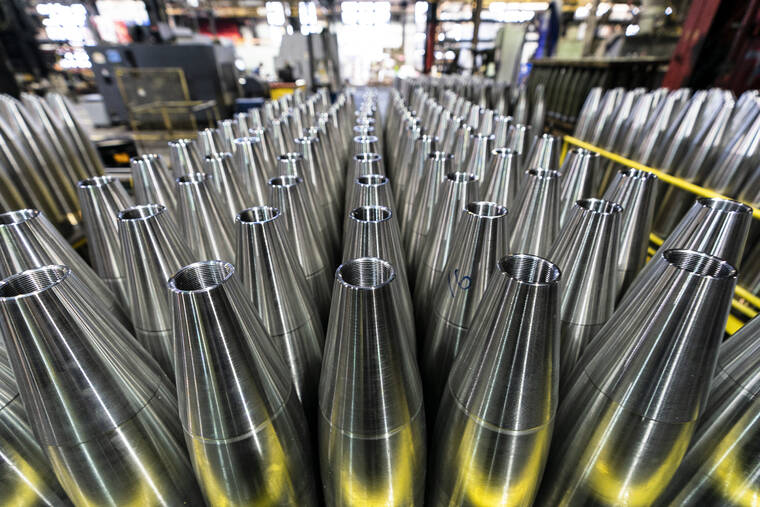Why the 155 mm round is so critical to the war in Ukraine

ASSOCIATED PRESS / APRIL 13
155 mm M795 artillery projectiles are stored during the manufacturing process at the Scranton Army Ammunition Plant in Scranton, Pa. The 155 mm howitzer round is one of the most requested artillery munitions of the Ukraine war. Already the U.S. has shipped more than 1.5 million rounds to Ukraine, but Kyiv is still seeking more.
WASHINGTON >> The 155 mm howitzer round is one of the most requested artillery munitions of the war in Ukraine. Already the U.S. has shipped more than 1.5 million rounds to Ukraine, but Kyiv is still seeking more.
A look at why this particular munition is so commonly used, and why it’s been so critical to the war in Ukraine.
WHAT IS THE 155 MM?
Essentially, the 155 mm round is a very big bullet, made up of four parts: the detonating fuse, projectile, propellant and primer.
Each round is about 2 feet (60 centimeters) long, weighs about 100 pounds (45 kilograms), and is 155 mm, or 6.1 inches, in diameter. They are used in howitzer systems, which are towed large guns that are identified by the range of the angle of fire that their barrels can be set to.
The 155 mm shells can be configured in many ways: They can be packed with highly explosive material, use precision-guided systems, pierce armor or produce high fragmentation.
Don't miss out on what's happening!
Stay in touch with breaking news, as it happens, conveniently in your email inbox. It's FREE!
Past variants have included smoke rounds to obscure troop movement and illumination rounds to expose an enemy’s position.
“The 155 mm round and the similar Soviet-era 152 mm rounds are so popular because they provide a good balance between range and warhead size,” said Ryan Brobst, a research analyst at the Foundation for the Defense of Democracies. “If you have too small a shell, it won’t do enough damage and go as far. If you have a larger shell, you can’t necessarily fire it as far. This is the most common middle ground, and that’s why it’s so widely used.”
155 MM HISTORY
The French first developed the 155 mm round to respond to World War I’s extensive trench warfare, and early versions included gas shells, Keri Pleasant, historian for the Army’s Joint Munitions Command, said in a statement to The Associated Press.
As World War I continued, the 155 mm gun became the most common artillery piece used by the Allies, Pleasant said, and the U.S. Army later adopted it as its standard field heavy artillery piece.
The U.S. military fielded its own version, the M1, for World War II. After the war, the new NATO alliance adopted the 155 mm as its artillery standard.
By the Korean War, the round had been modified again, with a cluster munition variant. “The round contained 88 submunitions, which were dispersed over a wide area to destroy vehicles, equipment, and personnel,” Pleasant said.
ITS USE IN UKRAINE
Howitzer fires can strike targets up to 15 to 20 miles (24 to 32 kilometers) away, depending on what type of round and firing system is used, which makes them highly valued by ground forces to take out enemy targets from a protected distance.
“Adversaries don’t have much warning of it coming. And it’s harder to hide from incoming rounds that are arcing in from the top, which makes it highly lethal,” Brobst said.
In Ukraine, 155 mm rounds are being fired at a rate of 6,000 to 8,000 a day, said Ukrainian parliamentary member Oleksandra Ustinova, who serves on Ukraine’s wartime oversight committee. They are eclipsed by the estimated 40,000 Russian variant howitzer rounds fired at them, she told reporters at a recent Washington event sponsored by the German Marshall Fund.
The Pentagon previously had said how many rounds it was providing in each of the security assistance packages being sent about every two weeks to keep weapons and ammunition flowing into Ukraine. But it stopped specifying the number of 155 mm rounds shipped in each package in February, citing operational security.
However, in its overall count of assistance provided to Ukraine since Russia invaded in February 2022, the Pentagon says it has sent more than 160 155 mm howitzers, more than 1.5 million 155 mm rounds, more than 6,500 precision-guided 155 mm rounds and more than 14,000 155 mm Remote Anti-Armor Mine (RAAM) Systems — essentially a 155 mm shell packed with four mines that scatter on the ground and can take out a Russian tank if it drives over them.
Other countries have also provided howitzers, but Kyiv has continually asked for more. As of last year Ukrainian officials were requesting as many as 1,000 howitzer systems to push Russian forces back.
SPRING OFFENSIVE
As Ukraine prepares for an intense counteroffensive this spring, it will likely need to fire 7,000 to 9,000 155 mm shells a day, said Yehor Cherniev, a member of Ukraine’s parliament who spoke to reporters at the German Marshall Fund event.
In recent months, the Biden administration has been using presidential drawdown authority to send ammunition directly from U.S. military stockpiles to Ukraine, instead of having to wait and buy rounds from defense firms, so they can get there in time for the anticipated Ukrainian counteroffensive.
The U.S. has also been training Ukrainian troops in Germany on how to better use the 155 mm rounds in combined arms tactics — coordinating strikes with targeting information provided by forward-based troops and other armored systems to maximize damage and reduce the number of rounds needed to take out a target.
Associated Press writer Nomaan Merchant contributed to this story.




